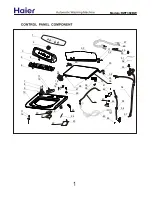
26
27
KDW4752N
EN
dishwasher
When loading the dishes and cutlery, please note
the following:
Dishes and cutlery must not impede the rotation of the spray arms.
Load hollow items such as cups, glasses, pans etc. with the opening
downwards so that water cannot collect in the container or a deep
base.
Dishes and items of cutlery must not lie inside one another, or cover
each other
• To avoid damage to glasses, they must not touch
• Load large items which are most difficult to clean into the lower rack
• The upper basket is designed to hold more delicate and lighter
dishware such as glasses, coffee and tea cups
Attention!
Long bladed knives stored in an upright position are a potential
hazard!
Long and/or sharp items of cutlery such as carving knives must be
positioned horizontally in the upper basket.
Damage to glassware and other dishes
Possible causes:
• Type of glass or manufacturing process. Detergent’s chemical
composition.
• Water temperature and duration of the dishwasher programme.
Suggested solution:
• Use glassware or porcelain dishes that have been marked
dishwasher-safe by the manufacturer.
• Use a mild detergent that is described as delicate on dishes. If
necessary, seek further information from detergent manufacturers.
• Select a low temperature programme.
• To prevent damage, take glasses and cutlery out of the dishwasher
as soon as possible after the programme finishes.
At the End of the Wash
When the working cycle has finished, the digital display “---”, then
stop. Turn off the appliance using the Power button, shut off the water
supply and open the door of the dishwasher. Wait a few minutes
before unloading the dishwasher to avoid handling the dishes and
utensils while they are still hot and more susceptible to breakage.
They will also dry better.
Starting a washing programme
Washing programme table
Programme Cycle Selection
Information
Description of
Cycle
Detergent
Pre/main
Running
Time
(min)
Energy
(kWh)
Water
(L)
Intensive
For the heaviest soiled
loads, such as pots,
pans, casserole dishes
and dishes that have
been sitting with dried
food on them for a while.
Pre-wash
Main wash (60ºC)
Rinse1
Rinse2
Hot rinse Drying
4/16 g
(or 3in1)
180
1.300 16
Eco
(*EN50242)
(Standard
Programme)
For normally soiled
loads, such as pots,
plates, glasses and
lightly soiled pans.
standard daily cycle.
Pre-wash
Main wash (44º C)
Hot rinse
Drying
4/16 g
(or 3 in 1)
237
0.922 11
For lightly and normally
soiled plates and pans
for every day. Run cycle
immediately after use)
Pre-wash
Main wash (50º C)
Rinse
Hot rinse Drying
3/15 g
90
0.890 14
A shorter wash for lightly
soiled loads that do not
need drying.
Main wash (40º C)
Hot rinse
15 g
30
0.500
7
Pre-Rinse
To rinse dishes that
you plan to wash later
that day
Pre-wash
/
11
0.010
4
Turning on the appliance
Starting a washing programme...
Pull out the lower and upper basket, load them with dishes and
proceed accordingly:
1.
Push them back. It is recommended to load the lower basket first,
then the upper one (refer to section “Loading the Dishwasher”).
Pour in the detergent.
2.
Insert the plug into the socket. The power supply is 220-240 V
AC 50 Hz, the specification of the socket is 12 A 250 VAC, 50 Hz.
Make sure the water supply is turned on to full pressure. Close the
door, press the ON/OFF button, press the “programme” button to
select a desired “Washing programme” (refer to section “Washing
programme Table”).
The Eco program is suitable to clean normally soiled tableware, it is
the most efficient program in terms of its combined energy and water















































